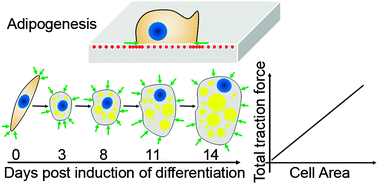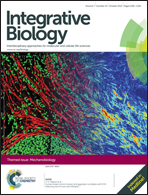Ratio of total traction force to projected cell area is preserved in differentiating adipocytes
Abstract
During obesity development, preadipocytes proliferate and differentiate into new mature adipocytes, to increase the storage capacity of triglycerides. The morphology of the cells changes during differentiation from an elongated spindle-shape preadipocyte into a rounded, differentiated adipocyte. That change allows efficient packing of spheroidal (triglyceride) lipid droplets in the cells, also reducing their ability to proliferate and migrate. The change in preadipocyte morphology is well known. However, little is known about the dynamic mechanical interactions of the cells with their microenvironment, and specifically the forces applied by the cells during and following differentiation. In this study, we evaluated changes in the morphology concurrently with the magnitude and location of forces applied by the cells onto a compliant gel-substrate. We found that the elongated preadipocytes applied forces concentrated at the poles of the cell, yet during differentiation the forces become more uniformly distributed around the cell and mostly at its perimeter. Furthermore, we observed that the total traction force per cell area is preserved, remaining essentially unchanged between preadipocytes and differentiated cells 3–14 days post-differentiation. At differentiation times longer than 8 days we also observed an increasing subset of cells that indent the gels, as opposed to merely applying horizontal traction forces. Our work provides insights into the dynamic mechanobiology of the adipogenesis process.

- This article is part of the themed collection: Mechanobiology

 Please wait while we load your content...
Please wait while we load your content...